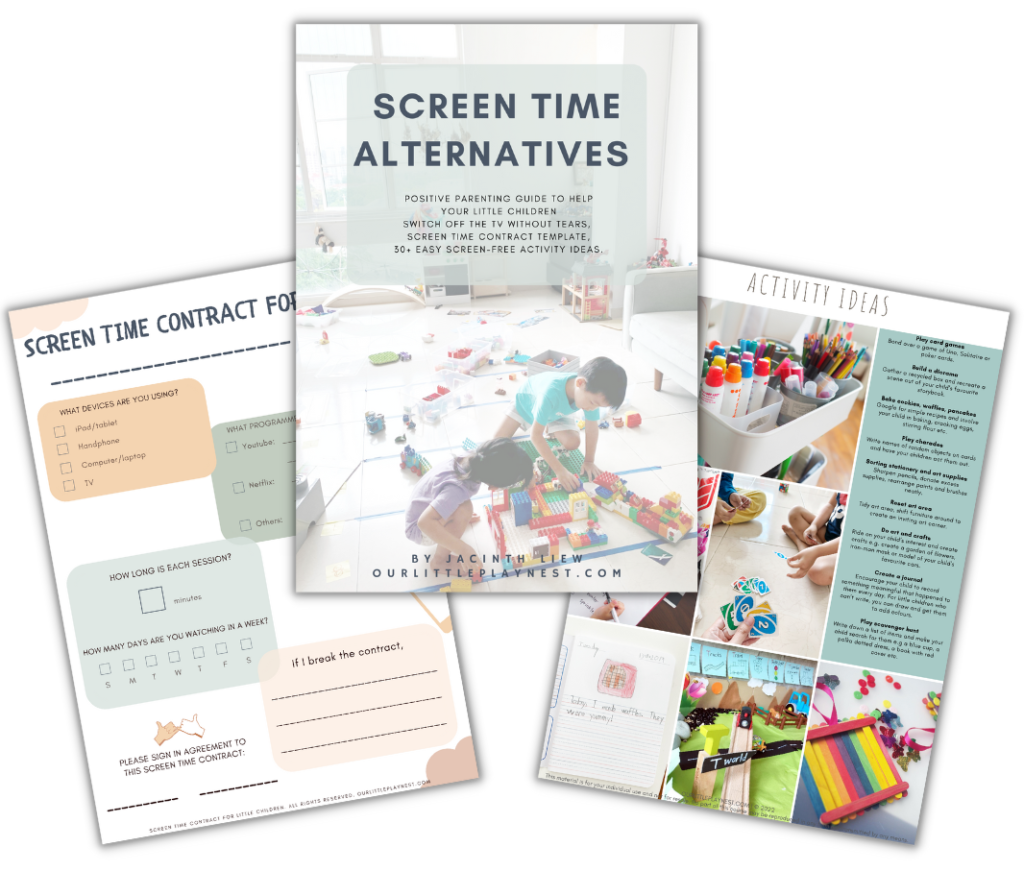In this article: Signs that your child needs a digital detox, and how to communicate with your kids about the screen time detox
There’s no denying it: it’s impossible for our children to avoid screens completely. From toddlers curiously peeking at our phones to school-aged kids asking for their own devices, screens have become a constant presence in our lives.
While technology can be beneficial, it’s crucial to help our children develop healthy screen habits. Especially from a young age!

I highly recommend you download my screen time alternatives guide – a positive parenting guide to help your little children switch off the TV without tears, screen time contract template and 30+ easy screen-free activity ideas.
If you feel like screens are dominating your household or negatively affecting family relationships, this post is for you. I’ll share practical tips to help you implement a digital detox and re-establish healthy screen habits at home.
Is your child overly dependent on screens?
Here are some common signs that your child might benefit from a digital detox:
- Does maintaining peace in your home often require screens?
- Are toys and non-screen activities being ignored?
- Do your kids throw massive tantrums when screen time ends?
If you answered yes to any of these questions, it’s time to consider a digital detox. A detox doesn’t mean eliminating screens forever, but resetting daily routines to create healthier habits.
How to implement a digital detox at home:
STEP 1: Prepare for the screen detox
A little preparation goes a long way. Start by making toys and activities inviting and accessible to encourage independent play.
Choose a suitable date to begin the detox, and communicate the plan to your kids in advance.
For example, you could say:
“Starting next week, we’re going to pause watching shows and using the iPad. I know this might feel upsetting because you enjoy them, but we’ve noticed that too much screen time isn’t helping our family. We will work together to find fun things to do instead.”
Setting clear expectations helps your kids mentally prepare for the change.
STEP 2: Unplug for a season
 Yes, this step might be challenging—but it’s worth it. Unplug screen devices and remove them from immediate reach. Expect tears, protests, and big emotions during the first few days. It will be hard for them to adjust to the change.
Yes, this step might be challenging—but it’s worth it. Unplug screen devices and remove them from immediate reach. Expect tears, protests, and big emotions during the first few days. It will be hard for them to adjust to the change.
Support your children through this transition by being present. Offer alternative activities, play with them, and reassure them that they can adapt. Kids are resilient, and over time, you’ll likely see them rediscover the joy of creative, independent play.
Children observe and mimic adult behaviours, so limiting your own screen use sets a strong example and reinforces the importance of the detox. Use this time to set aside your devices and engage in screen-free activities together, like reading or outdoor time.
STEP 3: Establish new screen time routines
Once your family has adjusted to daily life without screens, it’s time to introduce a structured routine for screen use.
Decide in advance:
- When screens are allowed (For example, weekends or specific times).
- How long they can use screens (For example, 15 minutes a day or 1 episode)
Tailor this screen time schedule to fit your family’s needs, and make sure it’s predictable. For instance, “You can watch TV on Saturdays after lunch for 30 minutes.” Clearly communicate those boundaries to your kids and ensure that devices are turned off when time is up.
Take baby steps when reintroducing screens. Observe their behaviour as you offer short durations of screen time. If they demonstrate good self-control in ending screen time, you can gradually increase the duration within the agreed limits.
Remember, you are in charge
As the parent, you set the boundaries. When screen time is up, turn off the devices and be ready to help your kids manage any emotions that come up. Your child has shown that they can thrive without screens during the detox—trust that they can continue to play independently and engage with non-screen activities.
This process takes patience, but it’s an investment towards your family’s well-being. You’ve got this!

Don’t forget to download my Free Screen Time Alternatives Guide to discover fun, screen-free activities for kids. Let’s help our children build healthy digital habits and strengthen family connections, one step at a time!


